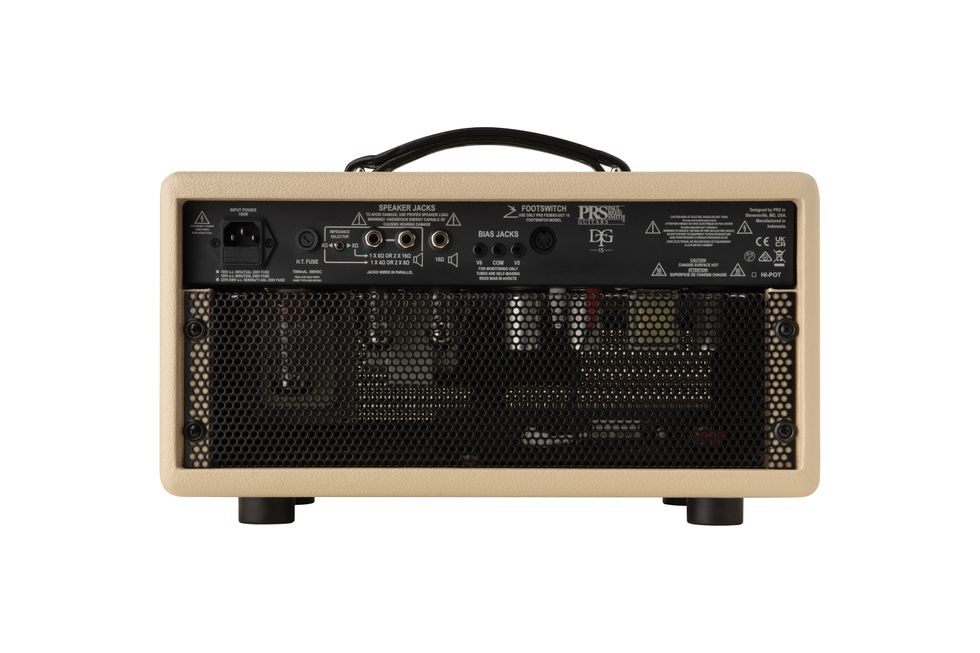The individuals behind the initials “PRS” and “DGT” have, over the last two decades, very nearly become their own little gear empire. The “DG” is, of course, acclaimed Texas guitar slinger David Grissom. The other fellow founded a little guitar and amplifier company in Maryland you may have heard of. (And he’s also a PG columnist.)
Grissom and Paul Reed Smith’s first collaboration appeared in 2007 in the shape of the Grissom DGT—a signature instrument that’s seen many iterations since. His Custom 30 amplifier followed five years later. But at 30 watts, that amp is pretty powerful for a lot of folks. So, this year PRS and their lead amp designer, Doug Sewell, unveiled the more club-friendly, tremolo-equipped DGT 15.
The basic architecture of the Indonesia-built DGT 15—single-channel, 2 x EL84 power section, 15 watts, and onboard reverb and tremolo—bears more than a little resemblance to a few important ’60s combo amps. But its 3-band EQ with presence, top-cut, and bright boost controls lends a lot of additional functionality and flexibility without cluttering the control panel or the playing experience. And, unlike some classic amps in this power class, the DGT 15 generates its wallop from a pair of output tubes in cathode bias, driven by three 12AX7s and one 12AT7 in the front end.
Feature Length
If the DGT 15’s control set were made up of just the EQ, presence, and top-cut controls, it would offer impressive tone-sculpting power. But the 3-way bright, boost, and master volume switches add exponentially more colors and gain contrasts. The bright switch is clever. It can be switched to always-on mode or set to disengage when the boost is on. The footswitchable boost, meanwhile, gives the single-channel DGT-15 the flex of a two-channel amp with a lead mode. Better still, you can set the amp up so you can activate the boost and master volume together—enabling access to the most headroom with the boost off and keeping the gain from running wild when the boost is engaged. The tremolo, too, can be activated via a mini-toggle or the included footswitch.
“While it’s basically clear, round, and full, depending on where you set the powerful EQ controls, you can reshape those tones into chunky, chiming, or sparkly variations on the clean theme.”
Because the DGT-15 is cathode biased, the output tubes require no re-biasing when you change them. But the back panel includes jacks for monitoring bias levels, which is handy for matching tubes or diagnosing possible issues. The back panel is also home to the 5-pin DIN footswitch jack and three speaker outs for various combinations of 4 ohm, 8 ohm, or 16 ohm cabs. Our test unit came with the ported-back PRS DG 1x12 cabinet, which is loaded with one 60-watt Celestion Vintage 30. The DGT 15 head itself is a little bigger than lunchbox-sized (unless you’ve got a particularly hefty appetite). But it’s still an easy load at just 17.25" x 9" x 9.25" and a hair under 20 pounds. The 1x12" cab is relatively compact too, at 24" x 22.18" x 10.5", and weighs 27 pounds.

Tejas Tone!
If you read only the specs for the DGT 15 (or never had the pleasure of playing a Custom 30), you’ll probably expect a British voice. But the DGT 15’s core tonality leans as much toward the 1960s black-panel Fender camp, and it has a ready-to-rumble personality that shines through whether you match it to an ES-355 or a Telecaster.
With Fender single-coils in the mix, non-boosted settings are very clean right up to around 3 o’clock on the volume, where the amp starts to edge into breakup just a little. That’s a lot of clean room to roam. But while it’s basically clear, round, and full, depending on where you set the powerful EQ controls you can reshape those tones into chunky, chiming, or sparkly variations on the clean theme. Humbuckers push the DGT 15 to juicier, crunchier zones much sooner, of course. Even so, the amp remains crisp and taut without going muddy. With both single-coils and humbuckers, the overdrive and saturation generated by the boost avoid the sizzly sounds you hear from many modern lead channels and overdrives. It’s also very dynamic—easing into light distortion when you pick hard, and shedding its aggressive edge when you use a light touch or reduce guitar volume. Overdrive pedals (in this case, a Klon-like Wampler Tumnus Deluxe, Marshall-style Friedman Small Box, and a multi-voiced Tsakalis Six) gel with both the boost and clean modes, too. The reverb and tremolo are superb. The range of both successfully spans subtle and more radical sounds—and between these, a couple of drive pedals, and the Boost function, a gigging guitarist can wrangle a lot of flexibility out of this amp.
The Verdict
Using the single-channel, 2 x EL84/reverb/tremolo architecture as a jumping-off point, the DGT 15 scales new heights of versatility—not just via flexible switching and tone-shaping power, but by melding Vox-y edge with Fender clarity and body at a very accessible price.



















